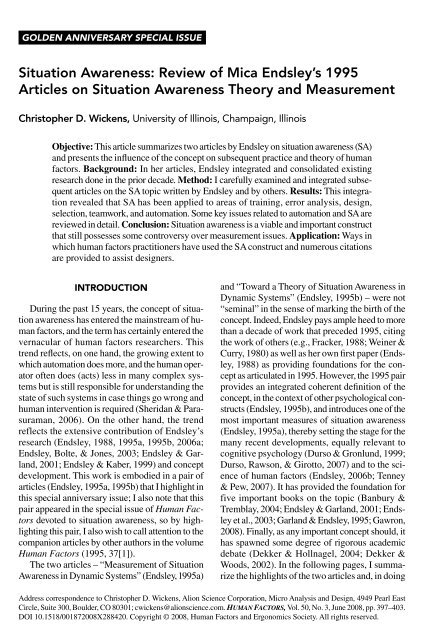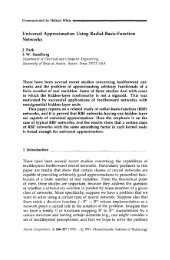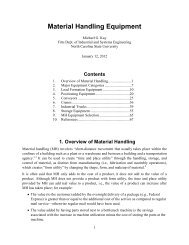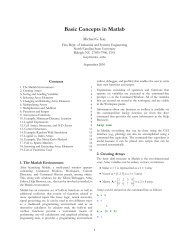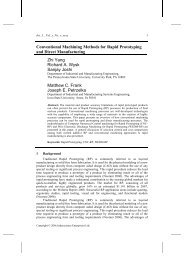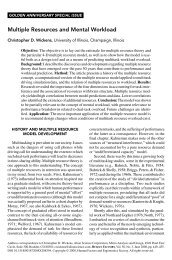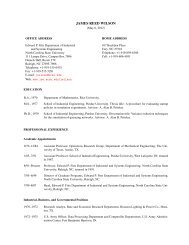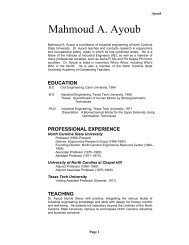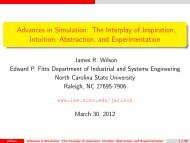Situation Awareness: Review of Mica Endsley's 1995 Articles on ...
Situation Awareness: Review of Mica Endsley's 1995 Articles on ...
Situation Awareness: Review of Mica Endsley's 1995 Articles on ...
You also want an ePaper? Increase the reach of your titles
YUMPU automatically turns print PDFs into web optimized ePapers that Google loves.
GOLDEN ANNIVERSARY SPECIAL ISSUE<br />
<str<strong>on</strong>g>Situati<strong>on</strong></str<strong>on</strong>g> <str<strong>on</strong>g>Awareness</str<strong>on</strong>g>: <str<strong>on</strong>g>Review</str<strong>on</strong>g> <str<strong>on</strong>g>of</str<strong>on</strong>g> <str<strong>on</strong>g>Mica</str<strong>on</strong>g> Endsley’s <str<strong>on</strong>g>1995</str<strong>on</strong>g><br />
<str<strong>on</strong>g>Articles</str<strong>on</strong>g> <strong>on</strong> <str<strong>on</strong>g>Situati<strong>on</strong></str<strong>on</strong>g> <str<strong>on</strong>g>Awareness</str<strong>on</strong>g> Theory and Measurement<br />
Christopher D. Wickens, University <str<strong>on</strong>g>of</str<strong>on</strong>g> Illinois, Champaign, Illinois<br />
Objective: This article summarizes two articles by Endsley <strong>on</strong> situati<strong>on</strong> awareness (SA)<br />
and presents the influence <str<strong>on</strong>g>of</str<strong>on</strong>g> the c<strong>on</strong>cept <strong>on</strong> subsequent practice and theory <str<strong>on</strong>g>of</str<strong>on</strong>g> human<br />
factors. Background: In her articles, Endsley integrated and c<strong>on</strong>solidated existing<br />
research d<strong>on</strong>e in the prior decade. Method: I carefully examined and integrated subsequent<br />
articles <strong>on</strong> the SA topic written by Endsley and by others. Results: This integrati<strong>on</strong><br />
revealed that SA has been applied to areas <str<strong>on</strong>g>of</str<strong>on</strong>g> training, error analysis, design,<br />
selecti<strong>on</strong>, teamwork, and automati<strong>on</strong>. Some key issues related to automati<strong>on</strong> and SAare<br />
reviewed in detail. C<strong>on</strong>clusi<strong>on</strong>: <str<strong>on</strong>g>Situati<strong>on</strong></str<strong>on</strong>g> awareness is a viable and important c<strong>on</strong>struct<br />
that still possesses some c<strong>on</strong>troversy over measurement issues. Applicati<strong>on</strong>: Ways in<br />
which human factors practiti<strong>on</strong>ers have used the SA c<strong>on</strong>struct and numerous citati<strong>on</strong>s<br />
are provided to assist designers.<br />
INTRODUCTION<br />
During the past 15 years, the c<strong>on</strong>cept <str<strong>on</strong>g>of</str<strong>on</strong>g> situati<strong>on</strong><br />
awareness has entered the mainstream <str<strong>on</strong>g>of</str<strong>on</strong>g> human<br />
factors, and the term has certainly entered the<br />
vernacular <str<strong>on</strong>g>of</str<strong>on</strong>g> human factors researchers. This<br />
trend reflects, <strong>on</strong> <strong>on</strong>e hand, the growing extent to<br />
which automati<strong>on</strong> does more, and the human operator<br />
<str<strong>on</strong>g>of</str<strong>on</strong>g>ten does (acts) less in many complex systems<br />
but is still resp<strong>on</strong>sible for understanding the<br />
state <str<strong>on</strong>g>of</str<strong>on</strong>g> such systems in case things go wr<strong>on</strong>g and<br />
human interventi<strong>on</strong> is required (Sheridan & Parasuraman,<br />
2006). On the other hand, the trend<br />
reflects the extensive c<strong>on</strong>tributi<strong>on</strong> <str<strong>on</strong>g>of</str<strong>on</strong>g> Endsley’s<br />
research (Endsley, 1988, <str<strong>on</strong>g>1995</str<strong>on</strong>g>a, <str<strong>on</strong>g>1995</str<strong>on</strong>g>b, 2006a;<br />
Endsley, Bolte, & J<strong>on</strong>es, 2003; Endsley & Garland,<br />
2001; Endsley & Kaber, 1999) and c<strong>on</strong>cept<br />
development. This work is embodied in a pair <str<strong>on</strong>g>of</str<strong>on</strong>g><br />
articles (Endsley, <str<strong>on</strong>g>1995</str<strong>on</strong>g>a, <str<strong>on</strong>g>1995</str<strong>on</strong>g>b) that I highlight in<br />
this special anniversary issue; I also note that this<br />
pair appeared in the special issue <str<strong>on</strong>g>of</str<strong>on</strong>g> Human Factors<br />
devoted to situati<strong>on</strong> awareness, so by highlighting<br />
this pair, I also wish to call attenti<strong>on</strong> to the<br />
compani<strong>on</strong> articles by other authors in the volume<br />
Human Factors (<str<strong>on</strong>g>1995</str<strong>on</strong>g>, 37[1]).<br />
The two articles – “Measurement <str<strong>on</strong>g>of</str<strong>on</strong>g> <str<strong>on</strong>g>Situati<strong>on</strong></str<strong>on</strong>g><br />
<str<strong>on</strong>g>Awareness</str<strong>on</strong>g> in Dynamic Systems” (Endsley,<str<strong>on</strong>g>1995</str<strong>on</strong>g>a)<br />
and “Toward a Theory <str<strong>on</strong>g>of</str<strong>on</strong>g> <str<strong>on</strong>g>Situati<strong>on</strong></str<strong>on</strong>g> <str<strong>on</strong>g>Awareness</str<strong>on</strong>g> in<br />
Dynamic Systems” (Endsley, <str<strong>on</strong>g>1995</str<strong>on</strong>g>b) – were not<br />
“seminal” in the sense <str<strong>on</strong>g>of</str<strong>on</strong>g> marking the birth <str<strong>on</strong>g>of</str<strong>on</strong>g> the<br />
c<strong>on</strong>cept. Indeed, Endsley pays ample heed to more<br />
than a decade <str<strong>on</strong>g>of</str<strong>on</strong>g> work that preceded <str<strong>on</strong>g>1995</str<strong>on</strong>g>, citing<br />
the work <str<strong>on</strong>g>of</str<strong>on</strong>g> others (e.g., Fracker, 1988; Weiner &<br />
Curry, 1980) as well as her own first paper (Endsley,<br />
1988) as providing foundati<strong>on</strong>s for the c<strong>on</strong>cept<br />
as articulated in <str<strong>on</strong>g>1995</str<strong>on</strong>g>. However, the <str<strong>on</strong>g>1995</str<strong>on</strong>g> pair<br />
provides an integrated coherent definiti<strong>on</strong> <str<strong>on</strong>g>of</str<strong>on</strong>g> the<br />
c<strong>on</strong>cept, in the c<strong>on</strong>text <str<strong>on</strong>g>of</str<strong>on</strong>g> other psychological c<strong>on</strong>structs<br />
(Endsley, <str<strong>on</strong>g>1995</str<strong>on</strong>g>b), and introduces <strong>on</strong>e <str<strong>on</strong>g>of</str<strong>on</strong>g> the<br />
most important measures <str<strong>on</strong>g>of</str<strong>on</strong>g> situati<strong>on</strong> awareness<br />
(Endsley, <str<strong>on</strong>g>1995</str<strong>on</strong>g>a), thereby setting the stage for the<br />
many recent developments, equally relevant to<br />
cognitive psychology (Durso & Gr<strong>on</strong>lund, 1999;<br />
Durso, Raws<strong>on</strong>, & Girotto, 2007) and to the science<br />
<str<strong>on</strong>g>of</str<strong>on</strong>g> human factors (Endsley, 2006b; Tenney<br />
& Pew, 2007). It has provided the foundati<strong>on</strong> for<br />
five important books <strong>on</strong> the topic (Banbury &<br />
Tremblay, 2004; Endsley & Garland, 2001; Endsley<br />
et al., 2003; Garland & Endsley,<str<strong>on</strong>g>1995</str<strong>on</strong>g>; Gawr<strong>on</strong>,<br />
2008). Finally, as any important c<strong>on</strong>cept should, it<br />
has spawned some degree <str<strong>on</strong>g>of</str<strong>on</strong>g> rigorous academic<br />
debate (Dekker & Hollnagel, 2004; Dekker &<br />
Woods, 2002). In the following pages, I summarize<br />
the highlights <str<strong>on</strong>g>of</str<strong>on</strong>g> the two articles and, in doing<br />
Address corresp<strong>on</strong>dence to Christopher D. Wickens, Ali<strong>on</strong> Science Corporati<strong>on</strong>, Micro Analysis and Design, 4949 Pearl East<br />
Circle, Suite 300, Boulder, CO 80301; cwickens@ali<strong>on</strong>science.com. HUMAN FACTORS, Vol. 50, No. 3, June 2008, pp. 397–403.<br />
DOI 10.1518/001872008X288420. Copyright © 2008, Human Factors and Erg<strong>on</strong>omics Society. All rights reserved.
398 June 2008 – Human Factors<br />
so, provide the less familiar reader with a sense<br />
<str<strong>on</strong>g>of</str<strong>on</strong>g> the importance <str<strong>on</strong>g>of</str<strong>on</strong>g> the c<strong>on</strong>struct. I then describe<br />
a few important subsequent developments in the<br />
field, forecast in Endsley (<str<strong>on</strong>g>1995</str<strong>on</strong>g>b).<br />
DEFINITIONS AND FUNDAMENTALS<br />
Endsley (<str<strong>on</strong>g>1995</str<strong>on</strong>g>b) defines situati<strong>on</strong> awareness informally<br />
and intuitively as “knowing what’s going<br />
<strong>on</strong>” and, more formally, as “the percepti<strong>on</strong> <str<strong>on</strong>g>of</str<strong>on</strong>g> the<br />
elements in the envir<strong>on</strong>ment within a volume <str<strong>on</strong>g>of</str<strong>on</strong>g><br />
time and space, the comprehensi<strong>on</strong> <str<strong>on</strong>g>of</str<strong>on</strong>g> their meaning<br />
and the projecti<strong>on</strong> <str<strong>on</strong>g>of</str<strong>on</strong>g> their status in the near<br />
future” (p. 36). The latter definiti<strong>on</strong> appears to have<br />
stood the test <str<strong>on</strong>g>of</str<strong>on</strong>g> time reas<strong>on</strong>ably well and is expressed<br />
in highly similar terms by other authors<br />
today (e.g., Durso, Raws<strong>on</strong>, & Girotto, 2007; Tenney<br />
& Pew, 2007). Importantly, then, her treatment<br />
both “drills down” to the comp<strong>on</strong>ents <str<strong>on</strong>g>of</str<strong>on</strong>g> this definiti<strong>on</strong><br />
and draws back to c<strong>on</strong>sider it in a larger c<strong>on</strong>text<br />
<str<strong>on</strong>g>of</str<strong>on</strong>g> human performance and cogniti<strong>on</strong>.<br />
In drilling down, Endsley draws the careful<br />
distincti<strong>on</strong> between the three levels <str<strong>on</strong>g>of</str<strong>on</strong>g> situati<strong>on</strong><br />
awareness (SA) defined by percepti<strong>on</strong> (including<br />
“noticing”), comprehensi<strong>on</strong>, and projecti<strong>on</strong>. Clearly,<br />
higher levels depend <strong>on</strong> the success <str<strong>on</strong>g>of</str<strong>on</strong>g> lower<br />
levels. Thus, the air traffic c<strong>on</strong>troller may first notice<br />
a change in trajectory (or <strong>on</strong>set <str<strong>on</strong>g>of</str<strong>on</strong>g> a c<strong>on</strong>flict<br />
alert), then comprehend that this means aircraft are<br />
now <strong>on</strong> a c<strong>on</strong>verging trajectory (laterally or vertically),<br />
and finally understand when, in the future,<br />
a c<strong>on</strong>flict may take place and how serious it will<br />
be. The diagnostic distincti<strong>on</strong> between these three<br />
levels is important, not <strong>on</strong>ly because they point to<br />
different perceptual/cognitive operati<strong>on</strong>s but also<br />
because breakdowns in each may have very different<br />
c<strong>on</strong>sequences for addressing them, through<br />
training or system design. For example, a breakdown<br />
<str<strong>on</strong>g>of</str<strong>on</strong>g> Level 1 SA would lead to the design <str<strong>on</strong>g>of</str<strong>on</strong>g><br />
better alerts. A breakdown <str<strong>on</strong>g>of</str<strong>on</strong>g> Level 3 SA would<br />
lead to incorporati<strong>on</strong> <str<strong>on</strong>g>of</str<strong>on</strong>g> predictive displays.<br />
Drawing back, Endsley c<strong>on</strong>siders the definiti<strong>on</strong><br />
in the c<strong>on</strong>text <str<strong>on</strong>g>of</str<strong>on</strong>g> other aspects <str<strong>on</strong>g>of</str<strong>on</strong>g> human-system<br />
interacti<strong>on</strong> and, in so doing, <str<strong>on</strong>g>of</str<strong>on</strong>g>fers the important<br />
service <str<strong>on</strong>g>of</str<strong>on</strong>g> explicitly characterizing what SAis not<br />
(exclusi<strong>on</strong>s), hence avoiding the pitfalls <str<strong>on</strong>g>of</str<strong>on</strong>g> merely<br />
characterizing SA as “good performance” and<br />
thereby also avoiding the creati<strong>on</strong> <str<strong>on</strong>g>of</str<strong>on</strong>g> a somewhat<br />
vacuous c<strong>on</strong>cept. These distincti<strong>on</strong>s are important<br />
and real both in terms <str<strong>on</strong>g>of</str<strong>on</strong>g> models <str<strong>on</strong>g>of</str<strong>on</strong>g> human informati<strong>on</strong><br />
processing and characterizati<strong>on</strong>s <str<strong>on</strong>g>of</str<strong>on</strong>g> system<br />
behavior. In particular, her writing emphasizes<br />
three things that SA is not.<br />
First, SA is not acti<strong>on</strong> or performance. That<br />
is, the understanding <str<strong>on</strong>g>of</str<strong>on</strong>g> a situati<strong>on</strong> is quite distinct<br />
from the manual or vocal acti<strong>on</strong> taken in resp<strong>on</strong>se<br />
to that situati<strong>on</strong> (even if that acti<strong>on</strong> is an<br />
informati<strong>on</strong>-seeking <strong>on</strong>e designed to improve<br />
SA). In this regard, the distincti<strong>on</strong> between SA<br />
and acti<strong>on</strong> is analogous to the classic distincti<strong>on</strong>s<br />
in decisi<strong>on</strong> theory between state-<str<strong>on</strong>g>of</str<strong>on</strong>g>-the-world estimati<strong>on</strong><br />
and choice (Edwards, 1961) and, in medicine,<br />
between diagnosis and treatment (Garg<br />
et al., 2005). Thus, <strong>on</strong>e might say that good SA is<br />
generally necessary but not sufficient for good<br />
performance. An operator with excellent SA <str<strong>on</strong>g>of</str<strong>on</strong>g> a<br />
failing system may not possess the knowledge <str<strong>on</strong>g>of</str<strong>on</strong>g><br />
procedures to remedy the failure or may not have<br />
the motor executi<strong>on</strong> skills to implement that remedy.<br />
In c<strong>on</strong>trast, when automati<strong>on</strong> can support effective<br />
performance, is it generally possible to<br />
have good system performance manifest in the absence<br />
<str<strong>on</strong>g>of</str<strong>on</strong>g> good SA. As an example here, a pilot who<br />
is flying a flight director may be accurately nulling<br />
the error symbol (and hence performing well by<br />
flying the plane al<strong>on</strong>g the desired path) but have<br />
very little awareness <str<strong>on</strong>g>of</str<strong>on</strong>g> where the plane is located<br />
over the ground.<br />
Sec<strong>on</strong>d, SAis not the same as l<strong>on</strong>g-term memory<br />
knowledge. Here it is important that the c<strong>on</strong>struct<br />
<str<strong>on</strong>g>of</str<strong>on</strong>g> SAis primarily applicable <strong>on</strong>ly in dynamic<br />
situati<strong>on</strong>s where variables are changing, typically<br />
over the course <str<strong>on</strong>g>of</str<strong>on</strong>g> sec<strong>on</strong>ds or minutes. The definiti<strong>on</strong><br />
<str<strong>on</strong>g>of</str<strong>on</strong>g>fered by Durso, Raws<strong>on</strong>, and Girotto (2007),<br />
“comprehensi<strong>on</strong> or understanding <str<strong>on</strong>g>of</str<strong>on</strong>g> a dynamic<br />
envir<strong>on</strong>ment” (p. 164), is appropriate here. Hence,<br />
static (declarative or procedural) knowledge about<br />
the state <str<strong>on</strong>g>of</str<strong>on</strong>g> the system, characterizing l<strong>on</strong>g-term<br />
memory, is less directly relevant to the c<strong>on</strong>tents <str<strong>on</strong>g>of</str<strong>on</strong>g><br />
SA, particularly at Level 2. Stated in other terms,<br />
the “time c<strong>on</strong>stant” <str<strong>on</strong>g>of</str<strong>on</strong>g> l<strong>on</strong>g-term memory (and its<br />
associated c<strong>on</strong>structs such as scripts, schemas, and<br />
mental models) is in the order <str<strong>on</strong>g>of</str<strong>on</strong>g> hours, days, and<br />
years, whereas the time c<strong>on</strong>stant <str<strong>on</strong>g>of</str<strong>on</strong>g> dynamic system<br />
changes, in which SAis the most relevant c<strong>on</strong>struct,<br />
is in the order <str<strong>on</strong>g>of</str<strong>on</strong>g> sec<strong>on</strong>ds, minutes, or, at<br />
most, a few hours. As such, the memory system<br />
more closely associated with SAappears to be that<br />
<str<strong>on</strong>g>of</str<strong>on</strong>g> l<strong>on</strong>g-term working memory (Durso & Gr<strong>on</strong>lund,<br />
1999; Ericss<strong>on</strong> & Kintch, <str<strong>on</strong>g>1995</str<strong>on</strong>g>; Wickens,<br />
2000).<br />
Third, the product <str<strong>on</strong>g>of</str<strong>on</strong>g> SA is not the same as the<br />
process <str<strong>on</strong>g>of</str<strong>on</strong>g> updating situati<strong>on</strong> awareness. This is<br />
a fuzzier exclusi<strong>on</strong>, paralleling the distincti<strong>on</strong><br />
that Adams, Tenney, and Pew (<str<strong>on</strong>g>1995</str<strong>on</strong>g>) make in the
SA: REVIEW OF ENDSLEY ARTICLES 399<br />
same Human Factors special issue between process<br />
and product. Two characteristics in particular<br />
are essential to the process <str<strong>on</strong>g>of</str<strong>on</strong>g> maintaining SA.<br />
Their discussi<strong>on</strong> illustrates the difficulty <str<strong>on</strong>g>of</str<strong>on</strong>g> establishing<br />
precise boundaries between process and<br />
product. (a) Attenti<strong>on</strong> (selective attenti<strong>on</strong>) directs<br />
the acquisiti<strong>on</strong> <str<strong>on</strong>g>of</str<strong>on</strong>g> informati<strong>on</strong> essential for Level 1<br />
SA. Indeed, the distincti<strong>on</strong> between process and<br />
product at Level 1 is quite fuzzy. (b) L<strong>on</strong>g-term<br />
memory is intimately involved with the process<br />
<str<strong>on</strong>g>of</str<strong>on</strong>g> SA updating at all levels. L<strong>on</strong>g-term memory<br />
knowledge will direct scanning (Wickens et al.,<br />
2008) to support Level 1. Knowledge structures<br />
(scripts, schemas, and expectancies) aid understanding<br />
and comprehensi<strong>on</strong> <str<strong>on</strong>g>of</str<strong>on</strong>g> the current state via<br />
top-down processes, thereby <str<strong>on</strong>g>of</str<strong>on</strong>g>ten allowing l<strong>on</strong>gterm<br />
working memory to replace the more fragile<br />
working memory (Durso, Raws<strong>on</strong>, & Girotto,<br />
2007). Finally, <strong>on</strong>e <str<strong>on</strong>g>of</str<strong>on</strong>g> the most critical elements for<br />
Level 3 predicti<strong>on</strong> is the mental model (Gentner<br />
& Stevens, 1983; Wils<strong>on</strong> & Rutherford, 1989), an<br />
agent that, in dynamic systems, can be “run” based<br />
<strong>on</strong> the perceived envir<strong>on</strong>mental inputs to project<br />
future outputs (Wickens, Gempler, & Morphew,<br />
2000). These aspects <str<strong>on</strong>g>of</str<strong>on</strong>g> l<strong>on</strong>g-term memory can<br />
clearly support expertise effects in the process <str<strong>on</strong>g>of</str<strong>on</strong>g><br />
updating SA. Even here, however, it is possible<br />
to make the clear distincti<strong>on</strong> between the learned<br />
(over a l<strong>on</strong>g time period) properties and rules embodied<br />
in the mental model and its more dynamic<br />
outputs, reflecting the changing envir<strong>on</strong>ment (the<br />
SA product).<br />
In her article, Endsley (<str<strong>on</strong>g>1995</str<strong>on</strong>g>b) does a nice job<br />
<str<strong>on</strong>g>of</str<strong>on</strong>g> explicitly outlining the relati<strong>on</strong>ship between<br />
SA and several other process-related c<strong>on</strong>cepts in<br />
psychology, such as automaticity, working memory,<br />
preattentive processing, percepti<strong>on</strong>, c<strong>on</strong>fidence,<br />
goals, plans, and scripts.<br />
APPLICATIONS OF SITUATION<br />
AWARENESS<br />
From the definiti<strong>on</strong> <str<strong>on</strong>g>of</str<strong>on</strong>g> what SA is, and is not,<br />
flows a series <str<strong>on</strong>g>of</str<strong>on</strong>g> important applicati<strong>on</strong>s addressed<br />
in the two articles (Endsley, <str<strong>on</strong>g>1995</str<strong>on</strong>g>a, <str<strong>on</strong>g>1995</str<strong>on</strong>g>b), and a<br />
plethora <str<strong>on</strong>g>of</str<strong>on</strong>g> research <strong>on</strong> these areas has followed.<br />
These include the following:<br />
Measurement. Endsley (<str<strong>on</strong>g>1995</str<strong>on</strong>g>a) lays out the criteria<br />
for SA measurement, c<strong>on</strong>trasts a series <str<strong>on</strong>g>of</str<strong>on</strong>g><br />
emerging techniques, and then describes in some<br />
detail the SAGAT (situati<strong>on</strong> awareness global<br />
assessment technique), which has subsequently<br />
become <strong>on</strong>e <str<strong>on</strong>g>of</str<strong>on</strong>g> the standard instruments. Here<br />
participants are intermittently queried, in the<br />
middle <str<strong>on</strong>g>of</str<strong>on</strong>g> a dynamic simulati<strong>on</strong>, about the values<br />
<str<strong>on</strong>g>of</str<strong>on</strong>g> various state parameters in the process<br />
under supervisi<strong>on</strong>. This query is issued when the<br />
display is blanked, so that the operator must rely<br />
<strong>on</strong> working memory to answer the questi<strong>on</strong>s. In<br />
the first <str<strong>on</strong>g>of</str<strong>on</strong>g> two experiments, she examines the<br />
extent <str<strong>on</strong>g>of</str<strong>on</strong>g> loss <str<strong>on</strong>g>of</str<strong>on</strong>g> SArevealed by SAGAT by probing<br />
at different time points across several minutes<br />
following each blank (see also Gugerty,<br />
1998). In the sec<strong>on</strong>d experiment, she addresses<br />
the critical issue <str<strong>on</strong>g>of</str<strong>on</strong>g> the extent to which such<br />
queries disrupt the process being measured (or<br />
disrupt it differentially across different c<strong>on</strong>diti<strong>on</strong>s).<br />
Importantly, her c<strong>on</strong>clusi<strong>on</strong>, echoed by<br />
Pew (2000), is that such interference is minimal<br />
(but see the following paragraphs). It is noteworthy<br />
that other approaches to SA measurement<br />
have been advocated. As <strong>on</strong>e example, the <str<strong>on</strong>g>Situati<strong>on</strong></str<strong>on</strong>g><br />
Present Assessment Measure, or SPAM<br />
(Durso, Raws<strong>on</strong>, & Girotto, 2007), assesses the<br />
speed <str<strong>on</strong>g>of</str<strong>on</strong>g> accessing informati<strong>on</strong> from a n<strong>on</strong>blanked<br />
display and provides a more sensitive,<br />
c<strong>on</strong>tinuously distributed (time) measure that will<br />
be less likely (than SAGAT) to be at floor levels<br />
because <str<strong>on</strong>g>of</str<strong>on</strong>g> memory decay. Comparis<strong>on</strong>s between<br />
the two approaches suggest both strengths and<br />
weaknesses <str<strong>on</strong>g>of</str<strong>on</strong>g> each (Alexander & Wickens,<br />
2005). As another example, the loss <str<strong>on</strong>g>of</str<strong>on</strong>g> SA can be<br />
inferred from changes in performance <strong>on</strong> tasks<br />
for which good SA is essential. For example, the<br />
freeway driver who pulls into another lane in<br />
fr<strong>on</strong>t <str<strong>on</strong>g>of</str<strong>on</strong>g> an overtaking car can be inferred to have<br />
poor SA. This would be an example <str<strong>on</strong>g>of</str<strong>on</strong>g> an implicit<br />
SA measure.<br />
Training. Techniques for training people to maintain<br />
good SAthrough informati<strong>on</strong> seeking (H<str<strong>on</strong>g>of</str<strong>on</strong>g>fman,<br />
Crandall, & Shadbolt, 1998) or teaching<br />
predictive skills (O’Brien & O’Hare, 2007) are<br />
quite distinct from those that might be applied to<br />
training other skills, such as learning procedures<br />
or practicing acti<strong>on</strong>s (Endsley & Roberts<strong>on</strong>,<br />
2000). Thus, the SAc<strong>on</strong>cept is important in allowing<br />
greater precisi<strong>on</strong> and definiti<strong>on</strong> <str<strong>on</strong>g>of</str<strong>on</strong>g> training<br />
requirements.<br />
Error analysis. Often training programs are implemented<br />
to remedy a specifically identified<br />
problem in human-system interacti<strong>on</strong>. In this<br />
regard, SA has served as a tool for accident and<br />
incident investigati<strong>on</strong>, revealing the major source<br />
<str<strong>on</strong>g>of</str<strong>on</strong>g> problems. Aclassic study by J<strong>on</strong>es and Endsley<br />
(1996) has helped to identify Level 1 SA as the<br />
dominant source <str<strong>on</strong>g>of</str<strong>on</strong>g> SA errors in aviati<strong>on</strong>. Corresp<strong>on</strong>ding<br />
findings have been observed for air<br />
traffic c<strong>on</strong>trol (Durso, Bleckley, & Dattel, 2007),<br />
a diagnosis that could directly trigger remedies<br />
in alerting system design, as well as attenti<strong>on</strong>al<br />
training (Gopher, 1992; O’Brien & O’Hare,<br />
2007; Wickens et al., 2008).<br />
Design. As with training, different approaches to
400 June 2008 – Human Factors<br />
system design would be taken if the procedures<br />
that followed were found wanting than if SA<br />
maintenance was inadequate; in the latter case,<br />
design would focus heavily <strong>on</strong> identifying informati<strong>on</strong><br />
needs for tasks, as well as the interpretable<br />
c<strong>on</strong>figurati<strong>on</strong> <str<strong>on</strong>g>of</str<strong>on</strong>g> these in displays (Endsley et al.,<br />
2003). In particular, because <str<strong>on</strong>g>of</str<strong>on</strong>g> the distincti<strong>on</strong>s<br />
between SAand routine performance, the display<br />
features to support global SA, necessary in the unexpected<br />
circumstances when things go wr<strong>on</strong>g,<br />
will need to be substantially different from those<br />
that support routine performance in normal operati<strong>on</strong>s<br />
(Wickens, 2000, 2002). This distincti<strong>on</strong><br />
between normal and abnormal informati<strong>on</strong> needs<br />
parallels that presented in ecological interface<br />
design (Vicente, 2002; Vicente & Rasmussen,<br />
1992).<br />
Predicti<strong>on</strong>. <str<strong>on</strong>g>Situati<strong>on</strong></str<strong>on</strong>g> awareness measures are<br />
found to predict and account for added variance in<br />
tasks such as air traffic c<strong>on</strong>trol, above and bey<strong>on</strong>d<br />
that accounted for by standard cognitive spatial<br />
tests (Durso, Bleckley, & Dattel, 2007; O’Brien<br />
& O’Hare, 2007).<br />
Teamwork. Within a few years following the appearance<br />
<str<strong>on</strong>g>of</str<strong>on</strong>g> the two articles, the issue <str<strong>on</strong>g>of</str<strong>on</strong>g> team<br />
situati<strong>on</strong> awareness emerged as important in<br />
understanding team dynamics: What does each<br />
worker know about the understanding and workload<br />
<str<strong>on</strong>g>of</str<strong>on</strong>g> the coworker, and how is this supported<br />
by interworker communicati<strong>on</strong>s and technology<br />
(Endsley & J<strong>on</strong>es, 2001) A critical issue c<strong>on</strong>cerns<br />
how the c<strong>on</strong>cept <str<strong>on</strong>g>of</str<strong>on</strong>g> “team SA” extends bey<strong>on</strong>d<br />
the collective average or sum <str<strong>on</strong>g>of</str<strong>on</strong>g> SA for the<br />
individuals who make up the team (Cooke &<br />
Gorman, 2006; Gorman, Cooke, & Winner, 2006;<br />
Cooke, Gorman, & Winner, 2007).<br />
Automati<strong>on</strong> and workload.Arguably the most critical<br />
aspect <str<strong>on</strong>g>of</str<strong>on</strong>g> SA articulated by Endsley (<str<strong>on</strong>g>1995</str<strong>on</strong>g>b)<br />
and further explored in research by Endsley and<br />
Kiris (<str<strong>on</strong>g>1995</str<strong>on</strong>g>), Endsley and Kaber (1999), and Kaber<br />
and Endsley (2003) is the intriguing trade-<str<strong>on</strong>g>of</str<strong>on</strong>g>f between<br />
workload and situati<strong>on</strong> awareness (Wickens,<br />
2002). Such a trade-<str<strong>on</strong>g>of</str<strong>on</strong>g>f can be expressed in two<br />
forms: (a) What are the circumstances in which the<br />
two c<strong>on</strong>structs covary in harm<strong>on</strong>y or in oppositi<strong>on</strong><br />
(b) How is this trade-<str<strong>on</strong>g>of</str<strong>on</strong>g>f mediated by the<br />
level <str<strong>on</strong>g>of</str<strong>on</strong>g> automati<strong>on</strong> in human-system interacti<strong>on</strong><br />
Endsley (<str<strong>on</strong>g>1995</str<strong>on</strong>g>b) addresses the first issue by identifying<br />
the four circumstances, generated by factorial<br />
combinati<strong>on</strong>s <str<strong>on</strong>g>of</str<strong>on</strong>g> high and low <strong>on</strong> each <str<strong>on</strong>g>of</str<strong>on</strong>g> the<br />
two variables, that could occur (see also Endsley,<br />
1993). For example, an increase in workload can<br />
divert resources from maintaining situati<strong>on</strong> awareness<br />
(hence decreasing the latter), but a welldesigned<br />
usable display can both reduce workload<br />
and increase situati<strong>on</strong> awareness.<br />
Regarding the sec<strong>on</strong>d <str<strong>on</strong>g>of</str<strong>on</strong>g> these workload-SA<br />
trade-<str<strong>on</strong>g>of</str<strong>on</strong>g>f issues, <strong>on</strong>e <str<strong>on</strong>g>of</str<strong>on</strong>g> the greatest seeds for important<br />
research is provided by Endsley’s (<str<strong>on</strong>g>1995</str<strong>on</strong>g>b)<br />
brief treatment <str<strong>on</strong>g>of</str<strong>on</strong>g> the role <str<strong>on</strong>g>of</str<strong>on</strong>g> automati<strong>on</strong> levels in<br />
mediating the trade-<str<strong>on</strong>g>of</str<strong>on</strong>g>f. This is followed by an important<br />
experimental examinati<strong>on</strong> <str<strong>on</strong>g>of</str<strong>on</strong>g> the trade-<str<strong>on</strong>g>of</str<strong>on</strong>g>f<br />
in Endsley and Kiris (<str<strong>on</strong>g>1995</str<strong>on</strong>g>). Of course, the c<strong>on</strong>cept<br />
<str<strong>on</strong>g>of</str<strong>on</strong>g> “level <str<strong>on</strong>g>of</str<strong>on</strong>g> automati<strong>on</strong>” (ratio <str<strong>on</strong>g>of</str<strong>on</strong>g> automati<strong>on</strong><br />
cognitive and motor “work” to human work, or the<br />
degree <str<strong>on</strong>g>of</str<strong>on</strong>g> authority imposed by automati<strong>on</strong>) predated<br />
Endsley’s writing and is generally credited<br />
to Sheridan and Verplank (1978). Furthermore, it<br />
has been elaborated in subsequent treatments<br />
by Kaber and Endsley (1997, 2003), Endsley and<br />
Kaber (1999), and Parasuraman and colleagues<br />
(Parasuraman, Sheridan, & Wickens, 2000; Parasuraman<br />
& Wickens, 2008 [this issue]). This<br />
research has examined the viability <str<strong>on</strong>g>of</str<strong>on</strong>g> the straightforward<br />
and intuitive assumpti<strong>on</strong> that, as the level<br />
<str<strong>on</strong>g>of</str<strong>on</strong>g> automati<strong>on</strong> increases, (a) workload decreases,<br />
and (b) situati<strong>on</strong> awareness (<str<strong>on</strong>g>of</str<strong>on</strong>g> the system c<strong>on</strong>trolled<br />
by automati<strong>on</strong>) decreases. Here decreased<br />
SA is a c<strong>on</strong>sequence both <str<strong>on</strong>g>of</str<strong>on</strong>g> less m<strong>on</strong>itoring <str<strong>on</strong>g>of</str<strong>on</strong>g><br />
the process that is automated (Level 1 SA) and<br />
<str<strong>on</strong>g>of</str<strong>on</strong>g> the reduced memory for system state, when<br />
that state has been changed by another agent (e.g.,<br />
automati<strong>on</strong>; Level 2 SA; the so-called generati<strong>on</strong><br />
effect; Slamecka & Graf, 1978).<br />
Such a trade-<str<strong>on</strong>g>of</str<strong>on</strong>g>f between two desirable states<br />
(high situati<strong>on</strong> awareness and low workload), to<br />
the extent that it exists, has major implicati<strong>on</strong>s for<br />
the design <str<strong>on</strong>g>of</str<strong>on</strong>g> automati<strong>on</strong>, such as that envisi<strong>on</strong>ed<br />
for the new air traffic c<strong>on</strong>trol system (Journal <str<strong>on</strong>g>of</str<strong>on</strong>g><br />
Air Traffic C<strong>on</strong>trol, 2006; Sheridan, 2007; Wickens,<br />
Mavor, Parasuraman, & McGee,1998). Given<br />
that level <str<strong>on</strong>g>of</str<strong>on</strong>g> automati<strong>on</strong> can be defined <strong>on</strong> a multilevel<br />
ordinal scale, as Endsley and Kiris (<str<strong>on</strong>g>1995</str<strong>on</strong>g>),<br />
following Sheridan and Verplank (1978), have<br />
d<strong>on</strong>e, then the relati<strong>on</strong>ship between level <str<strong>on</strong>g>of</str<strong>on</strong>g> automati<strong>on</strong><br />
and each comp<strong>on</strong>ent can be <str<strong>on</strong>g>of</str<strong>on</strong>g> the forms<br />
shown in Figure 1.<br />
a. If both functi<strong>on</strong>s are essentially linear (Figure 1a),<br />
and assuming equal performance by either human or<br />
automati<strong>on</strong>, then the “optimum level <str<strong>on</strong>g>of</str<strong>on</strong>g> SA” can be<br />
determined solely <strong>on</strong> the weighting given by system<br />
designers and users to the two c<strong>on</strong>structs, combined<br />
with the relative slopes <str<strong>on</strong>g>of</str<strong>on</strong>g> the two functi<strong>on</strong>s.<br />
b. If <strong>on</strong>e or both functi<strong>on</strong>s are exp<strong>on</strong>entially increasing<br />
(Figure 1b), then the optimum level will typically lie<br />
at either high or low ends <str<strong>on</strong>g>of</str<strong>on</strong>g> the level <str<strong>on</strong>g>of</str<strong>on</strong>g> automati<strong>on</strong><br />
(LOA) scale.<br />
c. If <strong>on</strong>e or both are logarithmically increasing (Figure<br />
1c), then an optimal LOAtypically can be found<br />
somewhere in the middle <str<strong>on</strong>g>of</str<strong>on</strong>g> the scale, with its precise<br />
locati<strong>on</strong> dependent <strong>on</strong> the regi<strong>on</strong> where the<br />
slopes <str<strong>on</strong>g>of</str<strong>on</strong>g> the two functi<strong>on</strong>s are equal.
SA: REVIEW OF ENDSLEY ARTICLES 401<br />
Workload reducti<strong>on</strong><br />
a<br />
<str<strong>on</strong>g>Situati<strong>on</strong></str<strong>on</strong>g> awareness<br />
Desirable<br />
Property<br />
b<br />
c<br />
Level <str<strong>on</strong>g>of</str<strong>on</strong>g> automati<strong>on</strong><br />
Figure 1. Three examples <str<strong>on</strong>g>of</str<strong>on</strong>g> two hypothetical functi<strong>on</strong>s representing the reducti<strong>on</strong> <str<strong>on</strong>g>of</str<strong>on</strong>g> workload, as well as the level <str<strong>on</strong>g>of</str<strong>on</strong>g><br />
situati<strong>on</strong> awareness (SA), as the level <str<strong>on</strong>g>of</str<strong>on</strong>g> automati<strong>on</strong> is increased. For both variables, high values <strong>on</strong> the y-axis represent<br />
good system properties. (a) Both functi<strong>on</strong>s are linear. (b) One functi<strong>on</strong> is geometrically (or exp<strong>on</strong>entially) changing.<br />
(c) One functi<strong>on</strong> is logarithmically changing. The text describes the implicati<strong>on</strong>s for each case for assessing the<br />
optimal level <str<strong>on</strong>g>of</str<strong>on</strong>g> automati<strong>on</strong>.<br />
The nature <str<strong>on</strong>g>of</str<strong>on</strong>g> these two functi<strong>on</strong>s is clearly an<br />
empirical questi<strong>on</strong>, and Endsley and Kiris (<str<strong>on</strong>g>1995</str<strong>on</strong>g>)<br />
appear to have been the first to systematically address<br />
this issue, in the c<strong>on</strong>text <str<strong>on</strong>g>of</str<strong>on</strong>g> an in-vehicle decisi<strong>on</strong><br />
support system for navigati<strong>on</strong>. Their data<br />
in that study appeared to establish a n<strong>on</strong>linearity<br />
in Level 2 SA and hence pointed to an intermediate<br />
LOA as optimal. Their data, however, were<br />
not overly clear-cut and so provided an instigati<strong>on</strong><br />
for further research <strong>on</strong> this all-important topic. Here<br />
again, subsequent studies by Kaber and Endsley<br />
(1997, 2003; Endsley & Kaber, 1999), addressing<br />
the same c<strong>on</strong>ceptual issue, in the c<strong>on</strong>text <str<strong>on</strong>g>of</str<strong>on</strong>g> different<br />
tasks, have revealed <strong>on</strong>ly partially satisfactory<br />
answers, generally favoring intermediate<br />
levels <str<strong>on</strong>g>of</str<strong>on</strong>g> automati<strong>on</strong> as optimizing the trade-<str<strong>on</strong>g>of</str<strong>on</strong>g>f<br />
(and hence suggesting the n<strong>on</strong>linearities <str<strong>on</strong>g>of</str<strong>on</strong>g> <strong>on</strong>e or<br />
both functi<strong>on</strong>s as in Figure 1c) but also revealing<br />
that the behaviors <str<strong>on</strong>g>of</str<strong>on</strong>g> the individual functi<strong>on</strong>s are<br />
not always c<strong>on</strong>sistent from <strong>on</strong>e applicati<strong>on</strong> to<br />
another (e.g., where there are changes vs. c<strong>on</strong>stancies<br />
between adjacent levels <str<strong>on</strong>g>of</str<strong>on</strong>g> automati<strong>on</strong>).<br />
Thus, although this important design issue has not<br />
been clearly resolved by the existing research, the<br />
work has established a clear “paradigm” in complex<br />
system research – and <strong>on</strong>e expressed at a sufficiently<br />
generic level as to be applicable in areas<br />
such as health care, highway driving, flying, and<br />
process c<strong>on</strong>trol.<br />
CRITICISMS OF SITUATION AWARENESS<br />
Criticisms <str<strong>on</strong>g>of</str<strong>on</strong>g> the SA c<strong>on</strong>cept can be c<strong>on</strong>ceptually<br />
distinguished as bel<strong>on</strong>ging to two categories.<br />
In the first <str<strong>on</strong>g>of</str<strong>on</strong>g> these are criticisms, or at least complementary<br />
views to Endsley’s approach, that nevertheless<br />
have embraced the c<strong>on</strong>cept <str<strong>on</strong>g>of</str<strong>on</strong>g> situati<strong>on</strong><br />
awareness. Key am<strong>on</strong>g these is the focus <strong>on</strong> differences<br />
in measurement discussed earlier (e.g.,<br />
SPAM; Durso, Raws<strong>on</strong>, & Girotto, 2007) and<br />
whether more naturalistic techniques such as implicit<br />
measures <str<strong>on</strong>g>of</str<strong>on</strong>g> SAare more appropriate. Also,<br />
as noted earlier, the distincti<strong>on</strong>s between SA and<br />
l<strong>on</strong>g-term memory remain fuzzy, in part because<br />
SA can be applied to c<strong>on</strong>structs, such as weather,<br />
that may change over relatively l<strong>on</strong>g time c<strong>on</strong>stants<br />
(hours and days). In the sec<strong>on</strong>d category<br />
are those who questi<strong>on</strong> the very validity and viability<br />
<str<strong>on</strong>g>of</str<strong>on</strong>g> the SAc<strong>on</strong>struct altogether (e.g., Dekker<br />
& Hollnagel, 2004; Dekker & Woods, 2002) as<br />
providing an unnecessary c<strong>on</strong>struct above already<br />
existing elements such as attenti<strong>on</strong>. To this, <strong>on</strong>e<br />
can speak to the increased use <str<strong>on</strong>g>of</str<strong>on</strong>g> the c<strong>on</strong>struct in<br />
both theory and applicati<strong>on</strong>s as testim<strong>on</strong>y to its<br />
viability, as well as note that such str<strong>on</strong>g criticism<br />
is also an index <str<strong>on</strong>g>of</str<strong>on</strong>g> the value <str<strong>on</strong>g>of</str<strong>on</strong>g> the SA c<strong>on</strong>cept to<br />
human factors science. This, as any science, will<br />
advance <strong>on</strong>ly through vigorous debate, and both<br />
critics and advocates <str<strong>on</strong>g>of</str<strong>on</strong>g> SA have c<strong>on</strong>tinued to
402 June 2008 – Human Factors<br />
keep this debate healthily alive (Parasuraman,<br />
Sheridan, & Wickens, 2008, in press).<br />
CONCLUSION<br />
The c<strong>on</strong>cept <str<strong>on</strong>g>of</str<strong>on</strong>g> situati<strong>on</strong> awareness lies at the<br />
heart <str<strong>on</strong>g>of</str<strong>on</strong>g> the intersecti<strong>on</strong> between basic cognitive<br />
psychology and the applied science <str<strong>on</strong>g>of</str<strong>on</strong>g> human<br />
factors. The two articles reviewed here, as well as<br />
the vast amount <str<strong>on</strong>g>of</str<strong>on</strong>g> Endsley’s other research, represent<br />
a critical c<strong>on</strong>tributi<strong>on</strong> within which a growing<br />
body <str<strong>on</strong>g>of</str<strong>on</strong>g> research was integrated and served to<br />
stimulate a productive and useful corpus <str<strong>on</strong>g>of</str<strong>on</strong>g> human<br />
factors c<strong>on</strong>clusi<strong>on</strong>s and further research. As automati<strong>on</strong><br />
c<strong>on</strong>tinues to be imposed in human work<br />
envir<strong>on</strong>ments, there is little doubt that the interest<br />
in how SA may degrade or be supported will<br />
c<strong>on</strong>tinue to grow.<br />
REFERENCES<br />
Adams, M., Tenney, Y., & Pew, R. W. (<str<strong>on</strong>g>1995</str<strong>on</strong>g>). <str<strong>on</strong>g>Situati<strong>on</strong></str<strong>on</strong>g> awareness and<br />
the cognitive management <str<strong>on</strong>g>of</str<strong>on</strong>g> complex systems. Human Factors,<br />
37, 85–104.<br />
Alexander, A. L., & Wickens, C. D. (2005). Synthetic visi<strong>on</strong> systems:<br />
Flightpath tracking, situati<strong>on</strong> awareness and visual scanning in an<br />
integrated hazard display. In R. Jensen (Ed.), Proceedings <str<strong>on</strong>g>of</str<strong>on</strong>g> the<br />
13th Internati<strong>on</strong>al Symposium <strong>on</strong> Aviati<strong>on</strong> Psychology (CD-ROM).<br />
Oklahoma City, OK: Federal Aviati<strong>on</strong> Administrati<strong>on</strong>. Retrieved<br />
March 7, 2008, from http://www.humanfactors.uiuc.edu/Reports&<br />
PapersPDFs/isap05/alexwicavpsy05.pdf<br />
Banbury, S., & Tremblay, S. (Eds.) (2004). A cognitive approach to situati<strong>on</strong><br />
awareness: Theory, measurement and applicati<strong>on</strong>. Aldershot,<br />
UK: Ashgate Publishing.<br />
Cooke, N. J., & Gorman, J. C. (2006). Assessment <str<strong>on</strong>g>of</str<strong>on</strong>g> team cogniti<strong>on</strong>. In<br />
W. Karwowski (Ed.), Internati<strong>on</strong>al encyclopedia <str<strong>on</strong>g>of</str<strong>on</strong>g> erg<strong>on</strong>omics and<br />
human factors (2nd ed., pp. 270–275). L<strong>on</strong>d<strong>on</strong>: Taylor & Francis.<br />
Cooke, N. J., Gorman, G. C., & Winner, J. L. (2007). Team cogniti<strong>on</strong>. In<br />
F. Durso, R. Nickers<strong>on</strong>, S. Dumais, S. Lewandowsky, & T. Perfect<br />
(Eds.), Handbook <str<strong>on</strong>g>of</str<strong>on</strong>g> applied cogniti<strong>on</strong> (2nd ed., pp. 239–268).<br />
Hoboken, NJ: Wiley.<br />
Dekker, S., & Hollnagel, E. (2004). Human factors and folk models.<br />
Cogniti<strong>on</strong>, Technology, and Work, 6, 79–86.<br />
Dekker, S. W. A., & Woods, D. D. (2002). MABA-MABA or abracadabra<br />
Progress <strong>on</strong> human-automati<strong>on</strong> coordinati<strong>on</strong>. Cogniti<strong>on</strong>,<br />
Technology, and Work, 4, 240–244.<br />
Durso, F., Bleckley, M. K., & Dattel, A. (2007). Does situati<strong>on</strong> awareness<br />
add to the validity <str<strong>on</strong>g>of</str<strong>on</strong>g> cognitive tests Human Factors, 48,<br />
721–733.<br />
Durso, F., & Gr<strong>on</strong>lund, S. D. (1999). <str<strong>on</strong>g>Situati<strong>on</strong></str<strong>on</strong>g> awareness. In F. T. Durso,<br />
R. Nickers<strong>on</strong>, R. Schvaneveldt, S. Dumais, M. Chi, & S. Lindsay<br />
(Eds.), Handbook <str<strong>on</strong>g>of</str<strong>on</strong>g> applied cogniti<strong>on</strong> (pp. 283–314). New York:<br />
Wiley.<br />
Durso, F., Raws<strong>on</strong>, K., & Girotto, S. (2007). Comprehensi<strong>on</strong> and<br />
situati<strong>on</strong> awareness. In F. Durso, R. Nickers<strong>on</strong>, S. Dumais,<br />
S. Lewandowsky, & T. Perfect (Eds.), Handbook <str<strong>on</strong>g>of</str<strong>on</strong>g> applied cogniti<strong>on</strong><br />
(2nd ed., pp. 163–194). Hoboken, NJ: Wiley.<br />
Edwards, W. (1961). Behavioral decisi<strong>on</strong> theory. Annual <str<strong>on</strong>g>Review</str<strong>on</strong>g> <str<strong>on</strong>g>of</str<strong>on</strong>g><br />
Psychology, 12, 473–489.<br />
Endsley, M. R. (1988). Design and evaluati<strong>on</strong> for situati<strong>on</strong> awareness<br />
enhancement. In Proceedings <str<strong>on</strong>g>of</str<strong>on</strong>g> the Human Factors Society 32nd<br />
Annual Meeting (pp. 97–101). Santa M<strong>on</strong>ica, CA: Human Factors<br />
Society.<br />
Endsley, M. R. (1993). <str<strong>on</strong>g>Situati<strong>on</strong></str<strong>on</strong>g> awareness and workload: Flip sides<br />
<str<strong>on</strong>g>of</str<strong>on</strong>g> the same coin. In R. S. Jensen & D. Neumeister (Eds.), Proceedings<br />
<str<strong>on</strong>g>of</str<strong>on</strong>g> the Seventh Internati<strong>on</strong>al Symposium <strong>on</strong> Aviati<strong>on</strong> Psychology<br />
(pp. 906–911). Columbus: Department <str<strong>on</strong>g>of</str<strong>on</strong>g> Aviati<strong>on</strong>, The<br />
Ohio State University.<br />
Endsley, M. R. (<str<strong>on</strong>g>1995</str<strong>on</strong>g>a). Measurement <str<strong>on</strong>g>of</str<strong>on</strong>g> situati<strong>on</strong> awareness in dynamic<br />
systems. Human Factors, 37, 65–84.<br />
Endsley, M. R. (<str<strong>on</strong>g>1995</str<strong>on</strong>g>b). Toward a theory <str<strong>on</strong>g>of</str<strong>on</strong>g> situati<strong>on</strong> awareness in dynamic<br />
systems. Human Factors, 37, 32–64.<br />
Endsley, M. R. (2006a). Expertise and situati<strong>on</strong> awareness. In K. A.<br />
Ericss<strong>on</strong>, N. Charness, P. J. Feltovich, & R. R. H<str<strong>on</strong>g>of</str<strong>on</strong>g>fman (Eds.), The<br />
Cambridge handbook <str<strong>on</strong>g>of</str<strong>on</strong>g> expertise and expert performance (pp.<br />
633–651). New York: Cambridge University Press.<br />
Endsley, M. R. (2006b). <str<strong>on</strong>g>Situati<strong>on</strong></str<strong>on</strong>g> awareness. In G. Salvendy (Ed.),<br />
Handbook <str<strong>on</strong>g>of</str<strong>on</strong>g> human factors and erg<strong>on</strong>omics (3rd ed., pp. 528–542).<br />
New York: Wiley.<br />
Endsley, M. R., Bolte, B., & J<strong>on</strong>es, D. G. (2003). Designing for situati<strong>on</strong><br />
awareness: An approach to human-centered design. L<strong>on</strong>d<strong>on</strong>: Taylor<br />
& Francis.<br />
Endsley, M. R., & Garland, D. G. (Eds.). (2001). <str<strong>on</strong>g>Situati<strong>on</strong></str<strong>on</strong>g> awareness<br />
analysis and measurement. Atlanta, GA: CRC Press.<br />
Endsley, M. R., & J<strong>on</strong>es, W. M. (2001). A model <str<strong>on</strong>g>of</str<strong>on</strong>g> inter- and intrateam<br />
situati<strong>on</strong> awareness: Implicati<strong>on</strong>s for design, training and measurement.<br />
In M. McNeese, E. Salas, & M. Endsley (Eds.), New trends in<br />
cooperative activities: Understanding system dynamics in complex<br />
envir<strong>on</strong>ments (pp. 46–67). Santa M<strong>on</strong>ica, CA: Human Factors and<br />
Erg<strong>on</strong>omics Society.<br />
Endsley, M. R., & Kaber, D. B. (1999). Level <str<strong>on</strong>g>of</str<strong>on</strong>g> automati<strong>on</strong> effects <strong>on</strong><br />
performance, situati<strong>on</strong> awareness and workload in a dynamic c<strong>on</strong>trol<br />
task. Erg<strong>on</strong>omics, 42, 462–492.<br />
Endsley, M. R., & Kiris, E. O. (<str<strong>on</strong>g>1995</str<strong>on</strong>g>). The out-<str<strong>on</strong>g>of</str<strong>on</strong>g>-the-loop performance<br />
problem and level <str<strong>on</strong>g>of</str<strong>on</strong>g> c<strong>on</strong>trol in automati<strong>on</strong>. Human Factors, 37,<br />
381–394.<br />
Endsley, M. R., & Roberts<strong>on</strong>, M. M. (2000). Training for situati<strong>on</strong><br />
awareness in individuals and teams. In M. R. Endsley & D. J.<br />
Garland (Eds.), <str<strong>on</strong>g>Situati<strong>on</strong></str<strong>on</strong>g> awareness analysis and measurement<br />
(pp. 349–366). Mahwah, NJ: Erlbaum. Retrieved March 7, 2008, from<br />
http://www.satechnologies.com/Papers/pdf/SATrainingchapter.pdf<br />
Ericss<strong>on</strong>, A., & Kintch, W. (<str<strong>on</strong>g>1995</str<strong>on</strong>g>). L<strong>on</strong>g term working memory. Psychological<br />
<str<strong>on</strong>g>Review</str<strong>on</strong>g>, 102, 211–245.<br />
Fracker, M. L. (1988). A theory <str<strong>on</strong>g>of</str<strong>on</strong>g> situati<strong>on</strong> assessment: Implicati<strong>on</strong>s for<br />
measuring situati<strong>on</strong> awareness. In Proceedings <str<strong>on</strong>g>of</str<strong>on</strong>g> the Human<br />
Factors Society 32nd Annual Meeting (pp. 102–106). Santa M<strong>on</strong>ica,<br />
CA: Human Factors Society.<br />
Garg, A. X., Adhikari, N. K. J., McD<strong>on</strong>ald, H., Rosas-Arellano, M. P.,<br />
Devereaux, P. J., Bevene, J., et al. (2005). Effects <str<strong>on</strong>g>of</str<strong>on</strong>g> computerized<br />
clinical decisi<strong>on</strong> support systems <strong>on</strong> practiti<strong>on</strong>er performance and<br />
patient outcomes: A systematic review. Journal <str<strong>on</strong>g>of</str<strong>on</strong>g> the American<br />
Medical Associati<strong>on</strong>, 293, 1223–1238.<br />
Garland, D. J., & Endsley, M. R. (<str<strong>on</strong>g>1995</str<strong>on</strong>g>). Experimental analysis and<br />
measurement <str<strong>on</strong>g>of</str<strong>on</strong>g> situati<strong>on</strong> awareness. Dayt<strong>on</strong>a Beach, FL: Embry-<br />
Riddle: Aer<strong>on</strong>autical University Press.<br />
Gawr<strong>on</strong>, V. J. (2008). Human performance, workload and situati<strong>on</strong><br />
awareness measures handbook, 2nd ed. Boca Rat<strong>on</strong>, FL: CRC Press.<br />
Gentner, D., & Stevens, A. L. (1983). Mental models. Hillsdale, NJ:<br />
Erlbaum.<br />
Gopher, D. (1992). The skill <str<strong>on</strong>g>of</str<strong>on</strong>g> attenti<strong>on</strong> c<strong>on</strong>trol: Acquisiti<strong>on</strong> and executi<strong>on</strong><br />
<str<strong>on</strong>g>of</str<strong>on</strong>g> attenti<strong>on</strong> strategies. In S. Kornblum & D. E. Meyer (Eds.),<br />
Attenti<strong>on</strong> and performance XIV: Synergies in experimental psychology<br />
(pp. 299–322). Cambridge, MA: MIT Press.<br />
Gorman, J. C., Cooke, N. J., & Winner, J. L. (2006). Measuring team<br />
situati<strong>on</strong> awareness in decentralized command and c<strong>on</strong>trol systems.<br />
Erg<strong>on</strong>omics, 49, 1312–1325.<br />
Gugerty, L. (1998). Evidence from a partial report task <str<strong>on</strong>g>of</str<strong>on</strong>g> forgetting from<br />
dynamic spatial memory. Human Factors, 40, 498–508.<br />
H<str<strong>on</strong>g>of</str<strong>on</strong>g>fman, R. R., Crandall, B., & Shadbolt, N. (1998). Use <str<strong>on</strong>g>of</str<strong>on</strong>g> the critical<br />
decisi<strong>on</strong> method to elicit expert knowledge. Human Factors,<br />
40, 254–276.<br />
J<strong>on</strong>es, D. G., & Endsley, M. R. (1996). Sources <str<strong>on</strong>g>of</str<strong>on</strong>g> situati<strong>on</strong> awareness<br />
errors in aviati<strong>on</strong>. Aviati<strong>on</strong>, Space and Envir<strong>on</strong>mental Medicine,<br />
67, 507–512.<br />
Journal <str<strong>on</strong>g>of</str<strong>on</strong>g> Air Traffic C<strong>on</strong>trol. (2006). Multiple articles. January–March<br />
2006.<br />
Kaber, D. B., & Endsley, M. R. (1997). Out-<str<strong>on</strong>g>of</str<strong>on</strong>g>-the-loop performance<br />
problems and the use <str<strong>on</strong>g>of</str<strong>on</strong>g> intermediate levels <str<strong>on</strong>g>of</str<strong>on</strong>g> automati<strong>on</strong> for<br />
improved c<strong>on</strong>trol system functi<strong>on</strong>ing and safety. Process Safety<br />
Progress, 16, 126–131.<br />
Kaber, D. B., & Endsley, M. R. (2003). The effects <str<strong>on</strong>g>of</str<strong>on</strong>g> level <str<strong>on</strong>g>of</str<strong>on</strong>g> automati<strong>on</strong><br />
and adaptive automati<strong>on</strong> <strong>on</strong> human performance, situati<strong>on</strong>
SA: REVIEW OF ENDSLEY ARTICLES 403<br />
awareness and workload in a dynamic c<strong>on</strong>trol task. Theoretical<br />
Issues in Erg<strong>on</strong>omic Science, 3, 1–40.<br />
O’Brien, K. S., & O’Hare, D. (2007). <str<strong>on</strong>g>Situati<strong>on</strong></str<strong>on</strong>g> awareness ability and<br />
cognitive skills training in a complex real-world task. Erg<strong>on</strong>omics,<br />
50, 1064–1091.<br />
Parasuraman, R., Sheridan, T. B., & Wickens, C. D. (2000). A model<br />
for types and levels <str<strong>on</strong>g>of</str<strong>on</strong>g> human interacti<strong>on</strong> with automati<strong>on</strong>. IEEE<br />
Transacti<strong>on</strong>s <strong>on</strong> Systems, Man, & Cybernetics: Part A: Systems and<br />
Humans, 30, 286–297.<br />
Parasuraman, R., Sheridan, T. B., & Wickens, C. D. (2008, in press). <str<strong>on</strong>g>Situati<strong>on</strong></str<strong>on</strong>g><br />
awareness, mental workload and trust in automati<strong>on</strong>: Viable<br />
empirically supported cognitive engineering c<strong>on</strong>structs. Cognitive<br />
Engineering and Decisi<strong>on</strong> Making.<br />
Parasuraman, R., & Wickens, C. D. (2008, this issue). Humans: Still vital<br />
after all these years <str<strong>on</strong>g>of</str<strong>on</strong>g> automati<strong>on</strong>. Human Factors, 50, 511–520.<br />
Pew, R. W. (2000). The state <str<strong>on</strong>g>of</str<strong>on</strong>g> situati<strong>on</strong> awareness measurement. In<br />
D. J. Garland & M. R. Endsley (Eds.), <str<strong>on</strong>g>Situati<strong>on</strong></str<strong>on</strong>g> awareness analysis<br />
and measurement (pp. 33–50). Mahwah, NJ: Erlbaum.<br />
Sheridan, T., & Parasuraman, R. (2006). Human-automati<strong>on</strong> interacti<strong>on</strong>:<br />
Tax<strong>on</strong>omies and Qualitative Models. In R. S. Nickers<strong>on</strong> (Ed.),<br />
<str<strong>on</strong>g>Review</str<strong>on</strong>g>s <str<strong>on</strong>g>of</str<strong>on</strong>g> human factors and erg<strong>on</strong>omics (Vol. 1, pp. 89–129).<br />
Santa M<strong>on</strong>ica, CA: Human Factors and Erg<strong>on</strong>omics Society.<br />
Sheridan, T. B. (2007, October). Human-automati<strong>on</strong> interacti<strong>on</strong> in the<br />
next-generati<strong>on</strong> air transportati<strong>on</strong> system. Presentati<strong>on</strong> given at<br />
the Human Factors and Erg<strong>on</strong>omics Society 51st Annual Meeting,<br />
Baltimore, MD.<br />
Sheridan, T. B., & Verplank, W. L. (1978). Human and computer c<strong>on</strong>trol<br />
<str<strong>on</strong>g>of</str<strong>on</strong>g> undersea teleoperators (Man-Machine Systems Laboratory Rep.).<br />
Cambridge, MA: MIT Press.<br />
Slamecka, N. J., & Graf, P. (1978). The generati<strong>on</strong> effect: Delineati<strong>on</strong> <str<strong>on</strong>g>of</str<strong>on</strong>g><br />
a phenomen<strong>on</strong>. Journal <str<strong>on</strong>g>of</str<strong>on</strong>g> Experimental Psychology: Human Learning<br />
Memory and Cogniti<strong>on</strong>, 4, 592–604.<br />
Tenney, Y. J., & Pew, R. W. (2007). <str<strong>on</strong>g>Situati<strong>on</strong></str<strong>on</strong>g> awareness catches <strong>on</strong>.<br />
What So what Now what In R. C. Williges (Ed.), <str<strong>on</strong>g>Review</str<strong>on</strong>g>s <str<strong>on</strong>g>of</str<strong>on</strong>g><br />
human factors and erg<strong>on</strong>omics (Vol. 2, pp. 89–129). Santa M<strong>on</strong>ica,<br />
CA: Human Factors and Erg<strong>on</strong>omics Society.<br />
Vicente, K., & Rasmussen, J. (1992). Ecological interface design:<br />
Theoretical foundati<strong>on</strong>s. IEEE Transacti<strong>on</strong>s <strong>on</strong> Systems, Man, and<br />
Cybernetics, 22, 589–606.<br />
Vicente, K. J. (2002). Ecological interface design: Progress and challenges.<br />
Human Factors, 44, 62–78.<br />
Weiner, E., & Curry, R. (1980). Flight deck automati<strong>on</strong>: promises and<br />
problems. Erg<strong>on</strong>omics, 23, 995–1012.<br />
Wickens, C. D. (2000). The trade-<str<strong>on</strong>g>of</str<strong>on</strong>g>f <str<strong>on</strong>g>of</str<strong>on</strong>g> design for routine and unexpected<br />
performance: Implicati<strong>on</strong>s <str<strong>on</strong>g>of</str<strong>on</strong>g> situati<strong>on</strong> awareness. In D. J.<br />
Garland & M. R. Endsley (Eds.), <str<strong>on</strong>g>Situati<strong>on</strong></str<strong>on</strong>g> awareness analysis and<br />
measurement (pp. 211–226). Mahwah, NJ: Erlbaum.<br />
Wickens, C. D. (2002). <str<strong>on</strong>g>Situati<strong>on</strong></str<strong>on</strong>g> awareness and workload in aviati<strong>on</strong>.<br />
Current Directi<strong>on</strong>s in Psychological Science, 11, 128–133.<br />
Wickens, C. D., Gempler, K., & Morphew, M. E. (2000). Workload and<br />
reliability <str<strong>on</strong>g>of</str<strong>on</strong>g> predictor displays in aircraft traffic avoidance.<br />
Transportati<strong>on</strong> Human Factors Journal, 2, 99–126.<br />
Wickens, C. D., Mavor, A. S., Parasuraman, R., & McGee, J. P. (Eds.).<br />
(1998). The future <str<strong>on</strong>g>of</str<strong>on</strong>g> air traffic c<strong>on</strong>trol: Human operators and automati<strong>on</strong>.<br />
Washingt<strong>on</strong>, DC: Nati<strong>on</strong>al Academy Press.<br />
Wickens, C. D., McCarley, J. S., Alexander, A., Thomas, L., Ambinder, M.,<br />
& Zheng, S. (2008). Human performance modeling in aviati<strong>on</strong>.<br />
Atlanta, GA: CRC Press.<br />
Wils<strong>on</strong>, J. R., & Rutherford, A. (1989). Mental models: Theory and applicati<strong>on</strong><br />
in human factors. Human Factors, 31, 617–634.<br />
Christopher D. Wickens is a senior scientist at Ali<strong>on</strong> Science<br />
Corporati<strong>on</strong>, Micro Analysis & Design Operati<strong>on</strong>s,<br />
Boulder, Colorado, and pr<str<strong>on</strong>g>of</str<strong>on</strong>g>essor emeritus at the University<br />
<str<strong>on</strong>g>of</str<strong>on</strong>g> Illinois at Urbana-Champaign. He received his<br />
Ph.D. in psychology from the University <str<strong>on</strong>g>of</str<strong>on</strong>g> Michigan<br />
in 1974.<br />
Date received: October 10, 2007<br />
Date accepted: March 20, 2008


